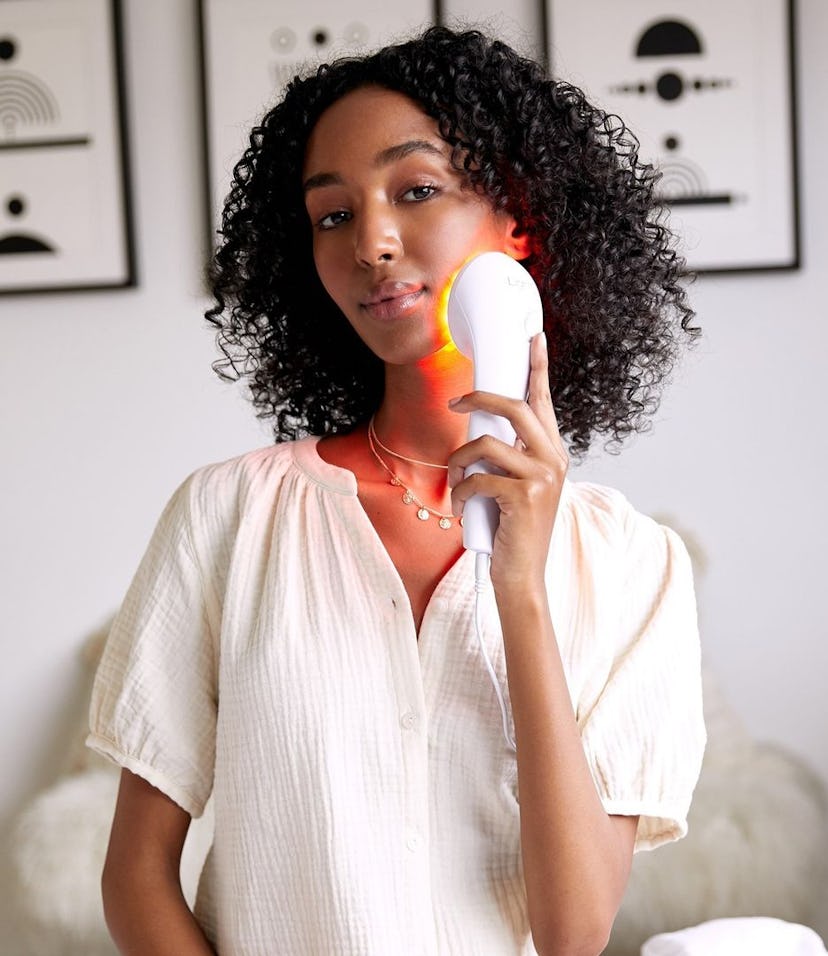(Skin)
The Truth About Those High-Frequency Acne Devices, Straight From Dermatologists
Do they actually work? The experts weigh in.

In our ever-evolving, endlessly-advancing world, skin care is starting to look as high-tech as your supercomputer smartphone. A far cry from the harsh actives, alcohol-soaked cleansers, and coarse scrubbing beads of yesteryear, today’s acne treatments are designed to be maximally effective while being as gentle with skin as possible. Sometimes that’s in the form of strategic ingredients, and sometimes it’s a handheld device developed by actual rocket scientists. High-frequency acne treatments, harnessing the power of electricity to help clear up stubborn blemishes, are rising in popularity through in-office treatments and at-home devices. But the often-high prices and foreign-sounding technology can leave many wondering just how effective those treatments really are. Luckily, it seems as if the experts are on board with the whole zit-zapping thing, too.
Read more: How To Treat Fungal Acne On Your Face When Nothing Else Works
These high-frequency devices and methods are often used as an alternative to topical and oral acne treatments, says Dr. Neil Sadick, M.D., of Sadick Dermatology in New York City. “More or less, all these devices deliver targeted thermal energy to the skin at various lengths.” When it comes to the popular handheld wands taking over Instagram feeds everywhere, electrical currents “heat the sebaceous gland and destroy the acne-causing bacteria,” Dr. Sadick says. They also oxygenate the skin, increase circulation, and calm inflammation. Most of these devices could be considered high-tech spot treatments: You simply wave the head of the wand over emerging pimples for a couple of minutes and it’s bye-bye, blemish.
Read more: Vibrating Facial Massage Tools Are Effective — But Are They Safe?
If you’re itching to see what these high-frequency acne treatment devices are all about, below, learn everything you need to know.
How High-Frequency Acne Devices Work
Of course, you can’t just hold up any electrical device to a zit and expect to instantly zap it into oblivion. These high-frequency tools specifically feature electrodes containing something called argon gas, which isn’t released until those electrodes actually touch the skin, Kerry Benjamin, licensed esthetician and founder of Stacked Skincare, explains. That argon gas then releases oxygen, which can’t co-exist with zit-causing bacteria, which is what actually defeats the acne.
“By destroying the bacteria and regulating the production of sebum, they help unclog the skin pores, and allow more efficacious diffusion of oxygen and nutrients,” Dr. Sadick adds.
Which Tools To Use
If this all sounds a little too good to be true, you’re not totally wrong. While top-quality high-frequency devices can be undoubtedly effective, they’re not a tool to skimp on. “You want to make sure to purchase a device that is well-rated and reviewed,” says Dr. Devika Icecreamwala, M.D., a dermatologist with Icecreamwala Dermatology. “Many of these devices fall apart easily, which can be dangerous when used on the face or close to the eyes.” However, the professionals agree that the at-home tools are relatively safe. “Devices like these for home use do not exploit high energies like the ones we use in-office,” Dr. Sadick says. Put bluntly: You’ll see results, just maybe not miracles.
How To Use High-Frequency Acne Devices
High-frequency gadgets usually come complete with a few different “heads” to target specific areas of the face. “The ‘pointy electrode’ is great for deeper cystic pimples; the ‘mushroom’ works for larger areas on your face, like your cheeks and forehead; and the ‘spoon’ is great for the under-eye area to help de-puff,” Benjamin explains. As for what to expect when you flip the power switch? A slight tingling sensation. Once you feel the tingle, “move the wand in a circular motion over the blemish for one to three minutes,” the esthetician instructs. You don’t need to actually touch the pimple you’re trying to shrink, though — it seems counterintuitive, but Benjamin says “the further the tip is away from the skin, the deeper the current will go. For full results, pull the tip a fourth of an inch away from your skin.” The device shouldn’t be used for more than 20 minutes at a time over your whole face, too.
Who Should Try One?
While high-frequency skin devices are safe for all skin types and tones, there are a few things to be cautious of before proceeding. If you’re pregnant or have a history of heart disease, you shouldn’t use them, Benjamin says, adding that users should also remove all jewelry before using their devices. And although high-frequency tools are aimed at eliminating acne, they should really only be used on the occasional pimple or cyst — chronic acne patients aren’t ideal candidates for this one, since it’s just too much surface area for one little wand to cover with true efficacy.
Extenuating circumstances aside, Dr. Sadick gives his blessing to go forth and zap those zits from the comfort of your couch. “I am a big fan of combination therapies and methodologies to maximize and prolong the results of in-office interventions, so I always advocate the use of home devices,” he says. “Together with a treatment regimen from your dermatologist, and an at-home skin care routine, these are an excellent complement for preventing breakouts and ensuring skin health.”
Ahead, the high-quality high-frequency tools to add to your routine ASAP.
We only include products that have been independently selected by The Zoe Report's editorial team. However, we may receive a portion of sales if you purchase a product through a link in this article.
This article was originally published on